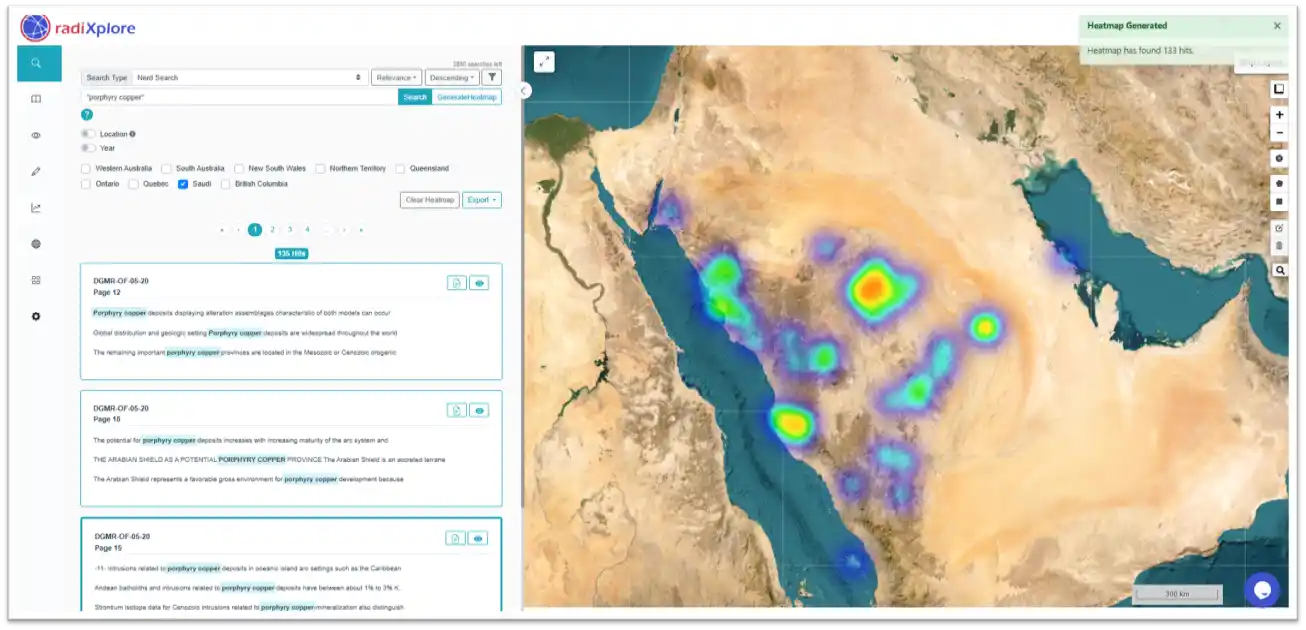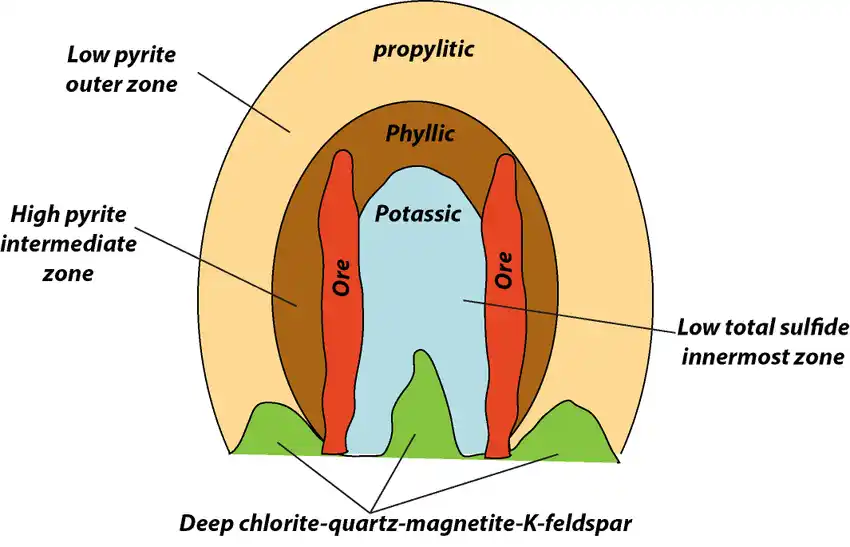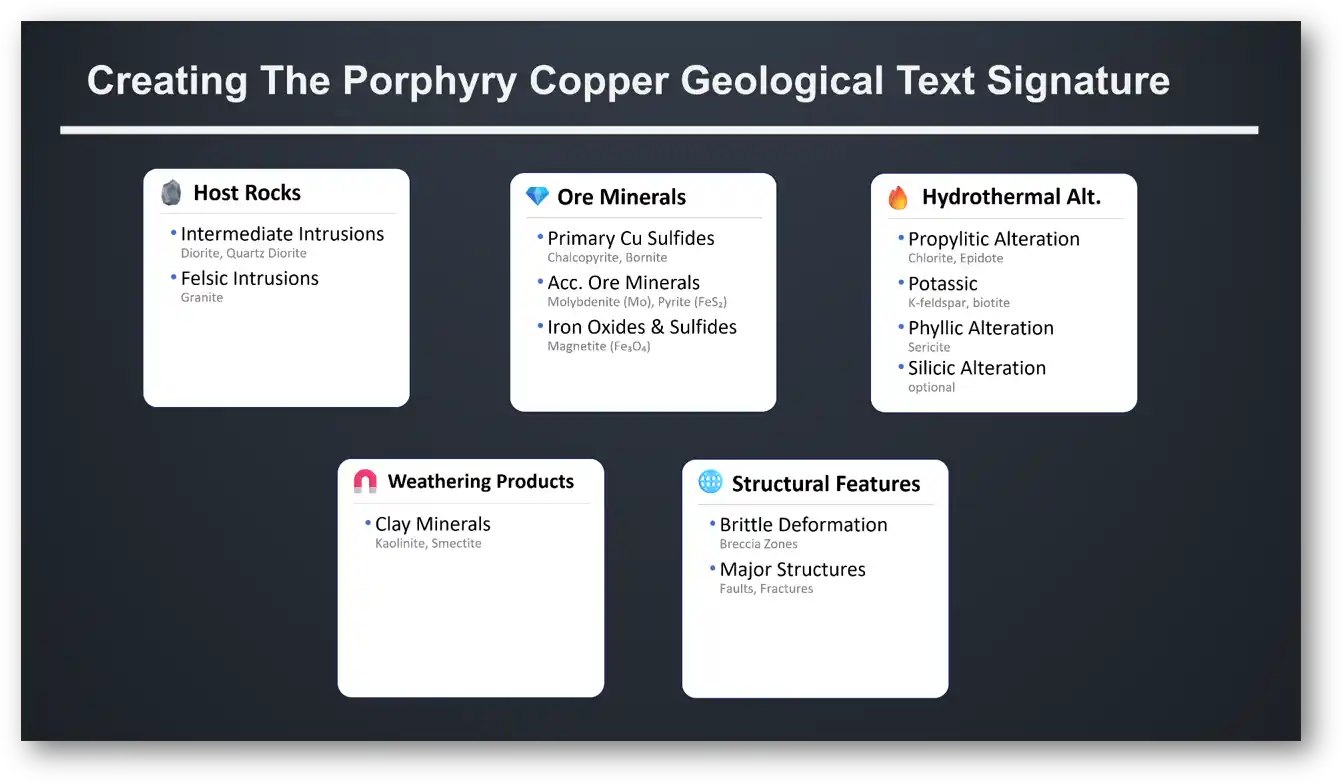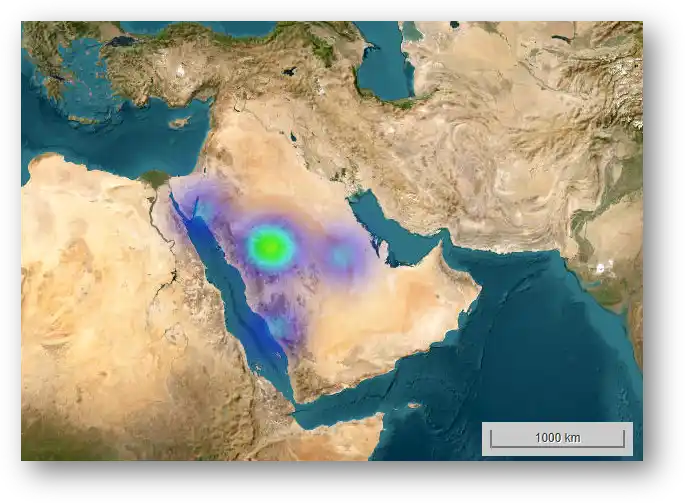Saudi Arabia's Next Copper Giant? How AI Reveals Overlooked Porphyry Clues in NGDR Data
Copper demand is soaring, but new porphyry deposits are scarce. Hidden clues in old exploration reports may hold the key. Discover how AI-powered analysis of Saudi Arabia’s NGDR data reveals overlooked copper potential—without replacing geologists

Porphyry copper deposits are among the most significant sources of copper worldwide, forming several kilometers below the Earth's surface. They derive their name from the porphyritic texture of the intrusive rocks associated with them. These deposits typically contain disseminated copper minerals within stockwork fractures and veins, encased in successive envelopes of hydrothermal alteration. In addition to copper, they often yield economically valuable by-products such as molybdenum, gold, silver, and other metals. The understanding and exploitation of these deposits have evolved significantly over the past century, driven by technological advancements and shifting market demands.
Characteristics of Porphyry Copper Deposits

- Geological Features: Porphyry deposits are associated with granitic to dioritic magmatic intrusions, breccia zones, and hydrothermal alteration zones, including potassic, quartz-sericite, and epidote-chlorite assemblages.
- Ore Grades: Copper grades generally range from 0.2% to over 1%, while molybdenum grades fall between 0.005% and 0.03%. Gold and silver content varies significantly.
- Deposit Size: These large-scale deposits can contain hundreds of millions to billions of metric tons of ore.
- Formation Environment: Most porphyry copper deposits form in subduction-related magmatic arcs or island arcs, often aligned with orogen-parallel geological belts.
Historical Development, Market Shifts, and the Case for Revisiting Legacy Data
The Evolution of Porphyry Copper Mining
Porphyry copper deposits emerged as the world’s dominant copper source in the early 20th century, enabled by breakthroughs in bulk-mining and processing technologies. Pioneering projects like Bingham Canyon (1906) and Chuquicamata (1915) demonstrated the economic viability of large-scale, low-grade operations. By the mid-20th century, foundational studies by Lowell & Guilbert (1970) and Sillitoe (1972–73) formalized genetic models, cementing porphyry deposits as the backbone of global copper supply.
However, exploration priorities have always been dictated by market forces. The 1990s saw a sharp pivot toward gold, driven by surging jewelry demand, financial crises (e.g., the Asian Financial Crisis), and a stock market boom that diverted investment away from base metals. Copper prices collapsed due to post-Soviet oversupply, rendering many porphyry projects uneconomical.
The Resurgence of Copper and the Supply Gap Challenge
The 2000s marked a dramatic reversal. China’s industrialization, renewable energy expansion, and the rise of electric vehicles (EVs) tripled global copper demand. Today, analysts project a 2.6% annual demand growth until 2035, with potential supply shortfalls as early as 2025. Yet, new discoveries are lagging, and greenfield projects face permitting delays and high capital costs.
Unlocking Hidden Potential: The Role of Legacy Data
This supply-demand imbalance creates a compelling case for re-examining historic exploration data—particularly reports focused on gold, molybdenum, or silver—for overlooked porphyry copper potential.
Why Revisit Old Literature?
- Commodity-Driven Blind Spots
- Many historic projects targeted high-grade gold or vein systems, dismissing low-grade copper mineralization.
- Porphyry deposits often host gold-molybdenum cores; past explorers may have ignored broader copper halos.
- Technological Limitations of the Past
- Early geochemical methods lacked the sensitivity to detect subtle copper anomalies.
- Alteration zoning (e.g., potassic, phyllic) was poorly understood pre-1970s.
- Modern Tools Enable Rediscovery
- AI-powered text analysis can scan decades of reports for keywords like "stockwork veining," "bornite," or "chalcopyrite" in gold-focused files.
- Machine learning integrates historic geochemistry with modern deposit models to flag high-priority targets.
Success Stories
- Resolution Copper (Arizona): Reevaluated in the 1990s after initial work in the 1960s; now one of the world’s largest undeveloped deposits.
- Quellaveco (Peru): Originally explored for silver, later recognized as a tier-one porphyry copper.
By marrying historic insights with 21st-century technology, explorers can unlock "new" deposits hidden in plain sight—reducing discovery timelines and capital risks while meeting critical global demand.
Can Mordern AI Systems like RAG Accurately Identify Copper Deposits?
Answering questions about known copper deposits should be straightforward, especially in an era where AI-powered search tools like ChatGPT, Gemini, and Perplexity can access vast amounts of web data, research articles, and publications. However, as I’ve discussed in previous blog posts and LinkedIn articles, Retrieval-Augmented Generation (RAG) systems—widely adopted by major mining companies—are not the “holy grail” for mineral discovery. Despite their promise, these systems often struggle with geological data accuracy, leading to misleading conclusions and hallucinated information.
While RAG systems excel at retrieving broad information, their reliance on existing digital content makes them prone to geological blind spots—especially where data is sparse or requires domain-specific interpretation.
To test this, I asked the above three leading LLM and RAG-based AI models:
Their responses were nearly identical, yet riddled with inaccuracies. Here’s what they generated, along with their cited sources:
2. Arabian Shield’s Mineral Terranes – While the Arabian Shield is mineral-rich, the response generalized across multiple countries without specifying any verified porphyry copper deposits in Saudi Arabia. The answer referenced this PorterGeo article.
3. Kutam Mine – A clear hallucination. The model misinterpreted geological reports, falsely identifying the Kutam Mine as a porphyry copper deposit when, in reality, its principal host rock is quartz porphyry. This confusion likely stems from mixing data between Saudi Arabia’s Kutam Mine and an unrelated Sudanese deposit mentioned in this Porter Geo article.
4. Zalm Area & Secondary Copper Sulphides – Referenced this ScienceDirect article which is not related to porphyry copper in Saudi.
5. Saudi Geological Survey's 856 Copper Sites – A misleading statistic without context; while copper prospects exist, the statement does not confirm the presence of porphyry copper systems.
6. Saudi’s $2.5 Trillion Mineral Wealth – While the country has vast mineral resources, citing this as evidence of major porphyry copper deposits is speculative at best.
This experiment underscores a fundamental issue with AI-driven RAG systems in geoscience: they rely on existing online content, which is often misinterpreted. Unlike a human geologist who can critically evaluate sources, AI struggles with contextual geological knowledge.
Could Older Deposits in Saudi Have Been Misinterpreted?
Is it possible that past exploration efforts in Saudi Arabia overlooked or underappreciated porphyry copper deposits due to a primary focus on gold and other base metals? Would re-evaluating historical data untapped copper potential?
- Historical Focus on Gold & Other Metals
- Saudi Arabia has a long history of gold mining, with major mines like Mahd adh Dhahab and Sukhaybarat.
- Early exploration efforts (pre-2000s) were often gold-centric, meaning copper occurrences may have been dismissed.
- Some gold-rich deposits globally (e.g., Chile’s Maricunga Belt) are part of larger copper-gold porphyry systems, suggesting potential re-evaluation opportunities.
- Evolving Geological Understanding
- Porphyry Models: Many porphyry systems were identified worldwide only after significant advancements in geological modeling.
- Alkaline vs. Calc-Alkaline Systems: Some porphyry deposits are linked to alkaline magmatism (e.g., Cadia, Australia), a factor that may not have been considered in earlier Saudi exploration.
- Tectonic Overprinting: Orogenic events may have obscured porphyry signatures in Saudi Arabia’s Arabian Shield, making them harder to detect with traditional techniques.
- Potential for Blind or Subtle Porphyry Systems
- Many porphyry systems are concealed beneath younger cover or exhibit weak surface expressions.
- Older exploration methods lacked deep-penetrating geophysical tools or advanced geochemical analyses that could reveal hidden deposits.
- Examples of Rediscovered Potential
- Jabal Sayid (Barrick): Initially explored for gold, later recognized as a significant copper deposit.
- Al Masane (Zn-Cu-Au): Initially considered a zinc-gold mine, with copper potential that may warrant re-evaluation.
- Wadi Bidah Belt: Known for VMS deposits, but some areas may exhibit porphyry affinities.
Leveraging AI Search with NGDR Bibliographic Reports for Undiscovered Porphyry Copper Deposits
The Saudi NGD Bibliographic Database is a critical component of the National Geological Database (NGD), managed by the Saudi Geological Survey (SGS). It serves as a vast digital repository of geological and mineral resource data, indexing:
- Books and maps
- Technical and open-file reports
- Scientific papers and SGS publications
The publicly available NGDR Bibliographic Database consists of 115,000+ pages across 4,000+ reports, though much of Saudi Arabia’s historical geological data remains private or proprietary (e.g., Aramco, Ma’aden holdings).
Saudi Arabia’s mineral exploration has traditionally prioritized gold and zinc, meaning porphyry copper potential remains largely underexplored. However, buried within NGDR reports may be critical clues to the next major copper discovery. By applying modern data-mining techniques, we can uncover overlooked information, including:
- Geological maps marking intrusive centers and alteration zones.
- Drill logs with unassayed copper intercepts.
- Geochemical surveys containing anomalous Cu-Mo-Au values that were dismissed as "background."
- Mineral reports describing porphyry-style features that were not investigated further.
Beyond RAG: How RadiXplore’s AI Search Augments Geologists Knowledge & Experience to Uncover Saudi Arabia’s Overlooked Porphyry Copper Potential
As demonstrated earlier, even advanced AI RAG systems fail to perform nuanced geological analysis at a human geoscientist’s level. However, no geologist—or even an entire team—can efficiently analyze hundreds of thousands of pages of geological data.
At RadiXplore, we have developed a geoscience-driven AI approach that harnesses the strengths of both human expertise and AI-driven automation:
RadiXplore’s AI-Enhanced Search Workflow:
- Geologist-Defined Geological Model: Using RadiXplore’s proprietary framework, geologists define the key characteristics of the porphyry copper model - Porphyry Copper Text Signature
- AI Geoscience Agent Optimization: An AI agent, trained on global research papers, refines and enhances this model - Refined Porphyry Copper Text Signature
- AI-Driven Literature Review: The AI system applies this refined model to NGDR reports—including maps, handwritten notes, and geological sections—to identify text patterns corresponding to to potential porphyry systems.
- Geospatial Analysis: Findings are mapped into a heatmap for spatial visualization and filtering.
- AI-Guided Interpretation: A AI Agent performs a second-pass AI analysis, interpreting results, flagging possible misclassified porphyry reports and suggesting additional validation steps.
- Final Report & Insights: The platform compiles and returns key insights, allowing geologists to focus on high-value targets.
This process is iterative, allowing geologists to inspect and refine results at every stage. By avoiding black-box retrieval—typical of RAG systems—it ensures geologists remain fully in control.
The Geologist uses RadiXplore's Text Signatrue Geological Model Framework to identify reports mentioning key geological features indicative of porphyry copper deposits. The search is structured into five key groups, each targeting essential components of the porphyry model.

- Host Rock Types
- These intrusive igneous rocks are typical of porphyry copper systems.
- The presence of diorite and quartz diorite suggests a calc-alkaline magmatic association.
- Granite is included to catch potential misclassifications or altered felsic intrusions.
- Ore Minerals
- Chalcopyrite & bornite are the primary copper sulfides in porphyry systems.
- Molybdenite
- Pyrite is included because it often forms in halos around the core of porphyry systems.
- Magnetite can be associated with potassic alteration.
- Alteration Minerals
- These minerals define hydrothermal alteration zones.
- Biotite & K-feldspar (potassic alteration) suggest high-temperature core zones.
- Chlorite & epidote (propylitic alteration) occur in outer halos.
- Sericite (phyllic alteration) indicates overprinting by later fluids.
- Supergene & Weathering Products
- Kaolinite & smectite form due to weathering or supergene alteration.
- Their presence might indicate a leached cap over a buried porphyry system.
- Structural Controls
- Structural features are key pathways for fluid flow.
- Faults & fractures control mineralization.
- Breccia zones can indicate hydrothermal brecciation related to porphyry formation.
This search helps scan NGDR reports to uncover overlooked mentions of porphyry-style mineralization. Since past exploration in Saudi Arabia focused on gold & VMS deposits, many porphyry-related indicators may be hidden amongst the geological descriptions. By searching across these five key geological components, we can systematically flag potential porphyry copper targets for deeper review.
Heatmap and Interpretation of Identified Results-

Above is a lower-resolution heatmap (with location data redacted) showcasing the identified areas. The documents flagged by the literature review process can be assessed either by a geologist or initially by the AI Geoscience Agent to determine if any of the findings suggest a potential porphyry copper deposit. While false positives are to be expected, we also identified promising true positives. Below is the interpretation of the results from the AI agent, with location details removed for confidentiality.
Interpretation Start:
Analyzing this 1980 Saudi report with a geologist's eye, there are definitely some intriguing features that, while not definitively pointing to a classic porphyry copper deposit, suggest potential for related mineralization and warrant further investigation. Here's a breakdown:
Potential Porphyry-Related Indicators:
- Quartz Diorite Intrusions:
- The presence of "heterogeneous quartz diorite" at Umm IJadid is a key factor. Quartz diorite is a common intrusive rock type associated with porphyry systems.
- Chalcopyrite:
- The mention of "chalcopyrite" at both Jabal as Sitarah and Umm IJadid is significant. Chalcopyrite is a primary copper-bearing mineral in porphyry deposits.
- Molybdenite:
- The presence of "molybdenite" in quartz veins within the Al Kushaymiyah ring structure and in pegmatites near Jabal Buhayran is a strong indicator. Molybdenite is frequently associated with porphyry systems.
- Quartz Veining and Stockwork Potential:
- The numerous quartz veins and extensive ancient workings (trenches and pits) at Umm IJadid suggest a significant hydrothermal event. While described as veins, the sheer volume of workings within the quartz diorite could indicate a disseminated style of mineralization or a stockwork system, especially with the mention of the large area of workings.
- Alteration:
- The mention of "granitized fine-grained amphibolite" and "contact metamorphosed sediments" indicates hydrothermal alteration. Further investigation of the alteration mineralogy is required.
- "Skarn in diorite" is mentioned. Skarns are often formed by hydrothermal fluids related to intrusions.
- Metal Association:
- The association of copper, lead, zinc, and silver in the gossans at ^ummat Umm Mugnifa and Al Kushaymiyah could indicate a broader hydrothermal system.
Reasons for Caution and Further Investigation:
- Gold and Base Metal Focus:
- The report heavily emphasizes gold, silver, lead, and zinc. This could indicate a focus on vein-type deposits rather than disseminated porphyry-style mineralization.
- Gossan Descriptions:
- While gossans can be associated with porphyry deposits, they can also form from the weathering of other types of sulfide mineralization.
- Vein-Dominated Descriptions:
- The descriptions of vein-hosted mineralization are prevalent, which is not the typical large disseminated ore body of a porphyry.
- Lack of Detailed Alteration Data:
- The report provides limited information on alteration mineralogy, which is crucial for identifying porphyry systems.
- Ancient Workings:
- Ancient workings do not prove a porphyry deposit, but do prove past hydrothermal fluid movement.
Geologist's Assessment:
- While the report doesn't definitively describe a classic porphyry copper deposit, it highlights several areas with significant hydrothermal activity and metal mineralization, particularly Umm IJadid and the Al Kushaymiyah ring structure.
- The presence of quartz diorite intrusions, chalcopyrite, and molybdenite, combined with the extensive quartz veining and alteration, warrants further investigation.
- Modern exploration techniques, including detailed geological mapping, geochemical analysis, and geophysical surveys, could reveal previously overlooked porphyry-style mineralization.
- The sheer scale of the Umm IJadid workings within the quartz diorite, and the presence of chalcopyrite, make this a very interesting area.
- The presence of molybdenite at several locations is a very positive indication.
- The skarn at yummat ash Shamiyah indicates hydrothermal fluid movement related to intrusions.
In conclusion, I would strongly recommend further exploration of these areas, particularly Umm IJadid and the Al Kushaymiyah ring structure, to assess their potential for porphyry copper or related mineralization. The presence of multiple indicators, even in a historical report, justifies a modern, comprehensive exploration program.
Interpretation End
This is an example of an AI-flagged report that may contain evidence of a misinterpreted porphyry copper deposit, along with its geological interpretation. Similarly, the AI Agent was able to analyze all the data retrieved during the AI-Driven Literature Review step to flag potential true positives which are then passed on to the geologist for further assesment.
Closing Thoughts: The Future of Mineral Exploration Lies in Data—and How We Interpret It
The case for revisiting legacy exploration data has never been stronger. As global copper demand surges and new discoveries lag, historical reports—often shelved or forgotten—may hold the key to unlocking overlooked deposits. Yet, as we’ve seen, conventional AI tools like RAG systems fall short when applied to nuanced geological challenges. The solution isn’t just more data; it’s smarter interpretation—combining geologists’ expertise with AI’s ability to scale.
At RadiXplore, we’re bridging that gap. Our approach doesn’t replace geologists; it amplifies their work, turning decades of unstructured data into actionable insights. Whether you’re reevaluating a regional archive or prioritizing drill targets, the right tools can transform historical clues into tomorrow’s discoveries.
Curious how this could apply to your project?
Let’s discuss how AI-augmented exploration might uncover what’s been hiding in your data. No hype—just practical insights.
Sign Up for Free to give the AI platform a try
